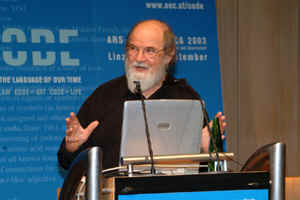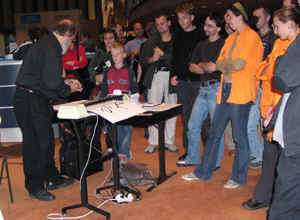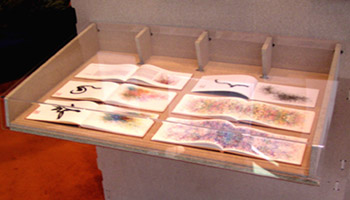|
<< Archive Menu | History | Main Menu | Search | Contact |
||||||||
|
Epigenetic Art Revisited: Epigenetische
Kunst im Rückblick: |
|
|||||||
| The Brucknerhaus exhibit | 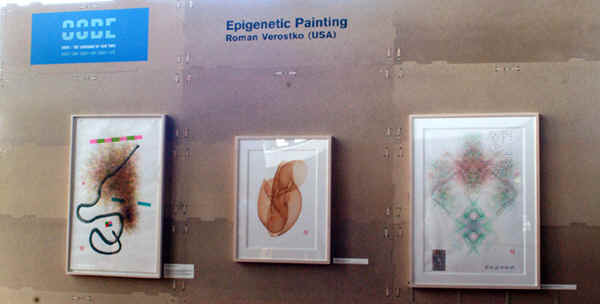 |
|||||||
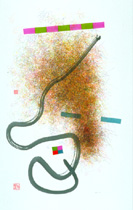 |
Carnival,
algorithmic pen & brush drawing, 1989. 24" by 40". An
early example of algorithmic procedures creating a work grown from the
relationship of an initiating set of coordinates. |
|||||||
 |
Cyberflower IV, Algorithmic pen drawing, 2000. 23" by 30". The cyberflower series demonstrates that a new frontier of form emerges for artists who create original form generators | |||||||

|
Saphire,
Ezekiel Series, algorithmic pen, brush & ink, 1993, 24”
by 40”. This
is one of the first works to generate both linear fields and geometric
shapes from the same initiating coordinate information. Recursive
self-similarity joins the tight linear arabesques and the seemingly
random distributions of lines. The initiator information is visually
identified in the lower left rectangular field that includes silver leaf
enhancement. |
|||||||
| Brucknerhaus
exhibit panel with book display case |
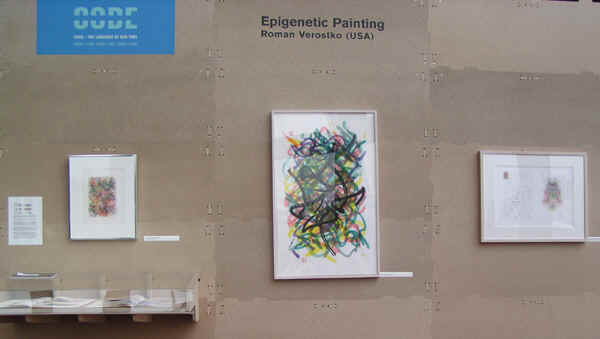 |
|||||||
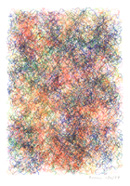
|
Untitled, algorithmic pen & ink drawing, 1987, 16” by 20”. Driving a multi-pen plotter the artist’s code made all the decisions for this work including pen color changes. | |||||||
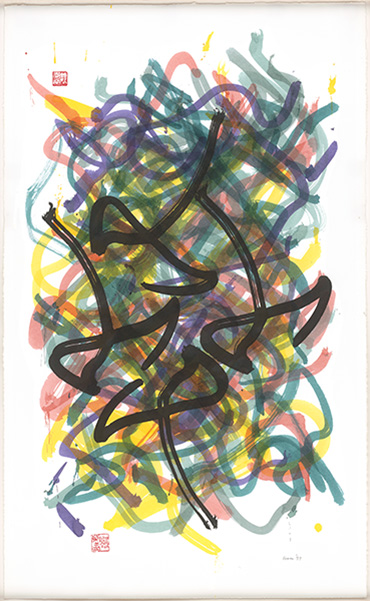
|
Untitled, algorithmic brush painting, 1989, 24” by 40”. Several brush paintings were made from 1987-89. The first brush strokes driven by coded procedures were executed in 1987. To achieve brush work the code pauses the machine and asks for a paint brush to be loaded with ink and placed in the plotter's drawing arm. The machine then executes the stroke. At first, for Roman, as a servant to the machine, the experience was humiliating and seemed foolish. The machine, named Brunelleschi, was master of the procedure via the code. In this painting the code rotated a brush stroke and repeated its character rhythmically. | |||||||
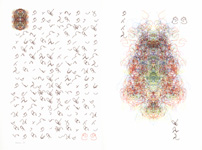 |
Untitled
page, Diamond Lake Apocalypse Series, algorithmic pen &
ink drawing, 1991, 24” by 20”. With a format reminiscent
of illuminated medieval manuscripts, this series was conceived as 20th
Century electronic scripts celebrating coded drawing procedures.
Roman came to view his studio as an electronic scriptorium with
pen plotter scribes delineating scripts and drawings. The left side
displays non-rational glyphic characters generated with a primitive
visual syntax. |
|||||||
|
|
Display case shows 5 originals and 1 reproduction copy from an illustrated limited edition of The Derivation of the Laws by George Boole. The text is Chapter III from Boole's Classic work, An Investigation of the Laws of Thought.. (Macmillan, London, 1854). This edition includes a Preface by Roger Malina, a statement by Roman and a Postscript. Open books on
display: (1) text page with printed illustration made with line-cut
zinc plate, (2) & (3) original Frontispieces; (4) Frontispiece
from the reproduction edition in black & gold , (5) & (6)
original end pieces. Rationale. This
edition was created as a tribute to the 19th Century
mathematician George Boole (1815-1864). Boole’s treatise on the Laws
demonstrates the direct link between Aristotle’s principle of
contradiction and the symbolic logic known today as Boolean Algebra.
Boolean logic, a symbolic language seminal to the development of
modern circuit boards, is fundamental to programming languages. The
illustrations for this edition, generated with principles outlined
in Boole’s Laws, exemplify the profound kinship emerging today between
art and coded procedure. Illustrations.
Each book has original front and end-piece drawings. These are all,
"one of a kind" works, drawn or brushed, stroke for stroke,
with a pen plotter driven by Roman’s code. Two families of form, 125 originals in each, introduced a
radically new procedure that Roger Malina has referred to as "post
mechanical" reproduction. This edition exemplifies epigenetic
art whereby a series of originals are generated in a family of forms
using the same parent code. This edition (1990) may be the first
instance where an algorithmic improvisational series of original
drawings was created for a bound limited edition. Edition. The limited edition of 125 copies, bound in leather, was pulled by hand at the St. Sebastian Press in Minneapolis in 1990. Each copy has original front and end pieces drawn with coded procedures in the artist's studio. Other illustrations were pulled with line cut plates made from original pen plotted drawings. The work was also issued in a reproduction paperback version based on the original type setting and plotter drawings (February 1991, ISBN 1-879508-07-9). The press is no longer active. The artist retains a limited number of copies of each edition. More on this edition |
|||||||
|
|
Neural:critical digital arts July 28, 2003 Neural.it-7-28-2003: Verostko-historical-algorithmic
|
|||||||
|
Epigenetic
Art Revisited: Software As Genotype, 2003 EXCERPT FROM ARS
ELECTRONICA CATALOGUE, 2003 Epigenesis refers to the process whereby a mature plant, the phenotype, grows from a seed, the genotype. For example an acorn embodies the genotype or code that contains the information needed for growing a mature oak tree. Given the proper environment it can, in time, grow into a mature tree, the phenotype. The “growing” process is called epigenesis. By analogy my code, likened to genotype, contains the information needed for generating an art form. Given the proper studio environment the code literally grows an art form. By analogy to biological epigenesis, this process may be viewed as epigenetic. Clearly any coded procedure that has the information necessary for generating an art form can be viewed as epigenetic. The more general term in current use is generative art. Content and meaning. For over a quarter century generative art has been creating the icons of our information age. These icons emerge as diagrams or visual analogues to the coded procedures by which they were made. The essential character of each finished work is derived from the "form-generating-procedure" or "algorithm" acting as genotype. For this reason the finished work becomes an epiphany, or manifestation, of its generator, the code. For me, each work celebrates the code that shaped its character. It is noteworthy that such procedures hold much in common with processes associated with crystallization and genetics. In general these works provide a window on unseen processes shaping mind and matter. By doing so they become icons illuminating the mysterious nature of self, earth and cosmos.” Click
here for the full text << Archive Menu | History | Main Menu | Search | Contact Deutch
"Im letzten Viertel des 20. Jahrhunderts waren viele Künstler von
der formengenerierenden Macht von Algorithmen fasziniert. Diese
codierten Prozeduren unterscheiden sich von traditionellen künstlerischen
Vorgehensweisen. Wie sollen wir diese Prozesse benennen? Das war eine
Frage, die meine Frau Alice und ich uns im Jahr 1986 stellten. Dabei
entdeckten wir, dass wir immer und wieder auf Ähnlichkeiten zwischen
biologischen Prozessen und kodierten Prozeduren stießen. Wir einigten
uns auf den Terminus "epigenetisch", und das war der
Ausgangspunkt für meinen Artikel Epigenetic Art aus dem Jahr
1988 (der 1990 in Leonardo veröffentlicht wurde). << Archive Menu | History | Main Menu | Search | Contact |
||||||||
